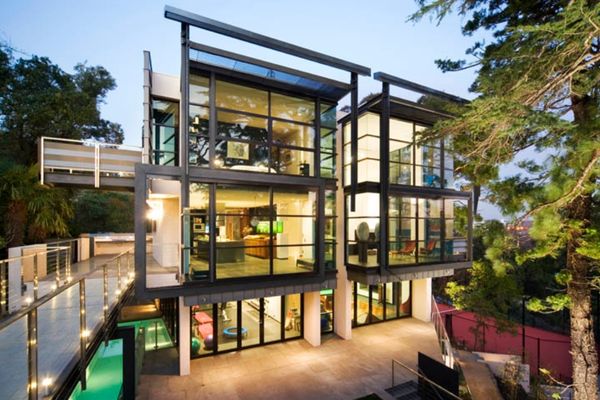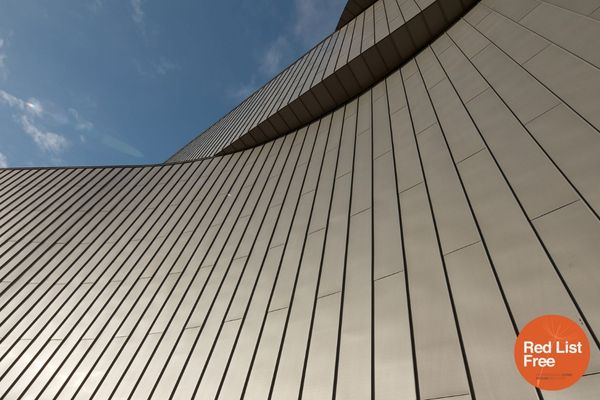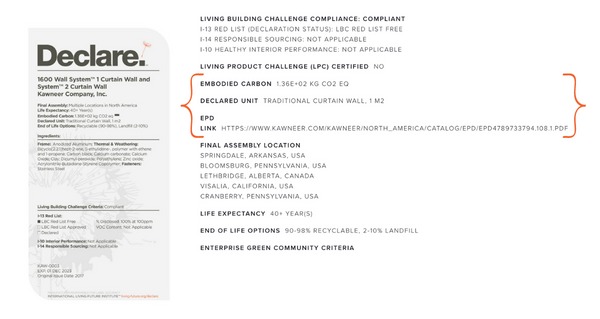
Pictured: Capral Aluminium Framing Systems
The Living Future Institute of Australia’s mission is to catalyse the transformation towards communities that are socially just, culturally rich and ecologically restorative. That means asking “what does good look like?” rather than outcomes being just a little less bad.
Regenerative design requires a shift in thinking that needs to be embedded in our education system and the entire built environment design, building and manufacturing process, from initial design through to end-of-life. A circular rather than linear model of production and consumption, involving sharing, leasing, repairing, repurposing, adapting, recycling, salvaging and reusing materials and products again and again… Sourcing responsibly in the first place and respecting the intrinsic value of extracted materials and the carbon invested in them, throughout their life cycle. This philosophy is embedded in the Living Building Challenge Materials Petal and the Declare program.
Materials transparency is key to shifting the product market supply chain, and increasing demand is generating supply. Availability of products with recycled content, organic matter or diverted “waste” is increasing in Australia. Many of the products on the Declare database are made from recycled ingredients and many are biodegradable/ compostable/ recyclable or have Take-Back program opportunities – all as identified on the Declare Label.
Circular thinking also involves using less and ensuring that products are put together in such a way that materials can be easily taken apart, such as modular design, clever detailing and mechanical fixings rather than adhesives, to facilitate dismantling for reuse or recycling. For example, Schiavello, which has 6 products with Red List Free Declare Labels, has a ‘Product Stewardship’ buyback program for customers offering to 1) buy back and resell as second-hand furniture; or 2) buy back and refurbish, change colour or add new components or 3) buy back and recycle. Removal of any powder coatings in a furnace returns components to their natural and raw state for repurposing or recycling.
It’s vital for specifiers and designers to be sure that we’re creating building and furnishing products that are healthy and safe for all species, now and into the future. That’s why specifiers find the free public Declare database such a useful resource – each Declare label shows where the product was assembled, what it is made from (at and above 100ppm = minimum 0.01%) and its end-of-life credentials. Any Red List content shows up in red text – the free public LBC Red List of the “worst in class” materials, chemicals, or elements prevalent in the building products industry and known to pose serious risks to human health and the greater ecosystem.
We’re proud to have so many local manufacturers join the Declare program and show the industry “what good looks like” in supply chain transparency. There’s an ever-increasing array of building product types on the database, allowing clients and specifiers to make informed and healthy choices for every part of the built environment. That’s the great thing about Declare, it’s not only for Living Building Challenge (LBC) project teams – it’s for everyone who cares that the products we use are safe for all species throughout time.
Huge thanks to all our Declare label holders who have been renewing their labels year after year, supporting our work, starting with EVCCO, the very first Declare Label in Australia six years ago. A warm welcome and congratulations to the manufacturers that have joined our program in the past 12 months – Capral, XLam, VMZinc, K8 Vic, Soprema, Supawood and Rubio Monocoat. We thank you all for your commitment and leadership and being part of another hugely successful year for Declare.

Pictured: VMZinc’s versatile Red List Free cladding
In terms of Program Alignments, Declare is an approved compliance pathway for the Living Building Challenge, LEED, International WELL Building Standard and Enterprise Green Communities Criteria. Declare and Living Product Challenge are also recognised under the Green Building Council of Australia (GBCA) Green Star Responsible Products Framework.
Some 2022 Highlights:
- Of the 93 Declare Labels in Australia, 79 are the highest achievable status – Red List Free – confirming that all ingredients (plus residuals present) at or above 100 ppm (0.01%) in the final product are disclosed and shown not to be on the LBC Red List. A further 3 Declare Labels are Red List Approved, having adopted one of the allowable exceptions but also containing absolutely no Red List Chemicals – an excellent accomplishment.
- Declare Labels in Australia and New Zealand comprise an incredible 15% of the >1100 Declare labels globally.
- Many of the products on Declare that are intended for interior use, have been demonstrated to be free from harmful emissions, by meeting the global benchmark CDPH STANDARD METHOD V1.2-2017 or equivalent. These manufacturers are leading the way through products that help create indoor spaces with healthy air quality and performance.

Pictured: GH Commercial’s biophilic design Red List Free carpet
Market-leading manufacturers are embracing transparency as an opportunity to proudly demonstrate their credentials, show leadership, drive change in their supply chain, better manage risk, connect with stakeholders and get on board the circular economy revolution. We look forward to the continued support of our existing Declare manufacturers and hearing from many new manufacturers wanting to join the program in the year ahead!
What’s Next for Healthy Materials

Pictured: Kawneer Declare listing with embodied carbon information
As circularity and carbon costing of materials and projects increasingly become vital considerations to drive down emissions, we’re delighted that embodied carbon is an optional field on a Declare label, having been an International Living Future Institute (ILFI) pilot program since 2019. The Environmental Product Declaration (EPD) submitted must be product-specific cradle-to-grave, or cradle-to-gate and include end-of-life options C1-C4. Have a look at the 17 products on Declare that have already disclosed embodied carbon here.

Pictured: LPC and Declare labels for The Living Site: Nylon Modular Carpet on Ecoflex Nxt Backing by Mohawk Group
For manufacturers wanting to reach even further beyond the stringent requirements of Declare, the Living Product Challenge is the next frontier. Currently, just 27 of the global Red List Free Declare Labels also have Living Product Challenge (LPC) certification (see LPC certified products here). We encourage our Australian-registered Declare manufacturers to continue to show leadership and take up the LPC challenge, and sincerely hope that in 2023 we can report our first Australian-registered Living Product Challenge certified products!

